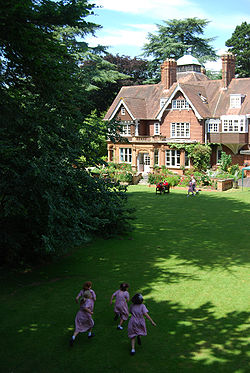
Rye St Antony School
Encyclopedia

Pullens Lane
Pullens Lane is in Headington, east Oxford, England. It is located at the top of Headington Hill, leading north off Headington Road to Jack Straw's Lane and Harberton Mead. The cul-de-sac Pullens Field leads off west from Pullens Lane.- Buildings :...
, Headington
Headington
Headington is a suburb of Oxford, England. It is at the top of Headington Hill overlooking the city in the Thames Valley below. The life of the large residential area is centred upon London Road, the main road between London and Oxford.-History:...
, Oxford
Oxford
The city of Oxford is the county town of Oxfordshire, England. The city, made prominent by its medieval university, has a population of just under 165,000, with 153,900 living within the district boundary. It lies about 50 miles north-west of London. The rivers Cherwell and Thames run through...
, England
England
England is a country that is part of the United Kingdom. It shares land borders with Scotland to the north and Wales to the west; the Irish Sea is to the north west, the Celtic Sea to the south west, with the North Sea to the east and the English Channel to the south separating it from continental...
. It is commonly abbreviated and referred to by both pupils and staff as 'Rye'. Rye is unique as a girls’ independent catholic school founded by lay women rather than by a religious order. The school has a strong rivalry with the neighbouring Headington Girls School.
History
The school was founded by Elizabeth Rendall and Ivy King in 1930, after a visit to the Church of St Anthony in Rye in SussexSussex
Sussex , from the Old English Sūþsēaxe , is an historic county in South East England corresponding roughly in area to the ancient Kingdom of Sussex. It is bounded on the north by Surrey, east by Kent, south by the English Channel, and west by Hampshire, and is divided for local government into West...
in commemoration of which the School was named. There have been only 4 Headmistresses in Rye's history.
The school was first situated in central Oxford before moving to its present site of 12 acres (4.9 ha) in Headington
Headington
Headington is a suburb of Oxford, England. It is at the top of Headington Hill overlooking the city in the Thames Valley below. The life of the large residential area is centred upon London Road, the main road between London and Oxford.-History:...
in 1939. The school grounds include a Victorian house built by Alfred Waterhouse
Alfred Waterhouse
Alfred Waterhouse was a British architect, particularly associated with the Victorian Gothic Revival architecture. He is perhaps best known for his design for the Natural History Museum in London, and Manchester Town Hall, although he also built a wide variety of other buildings throughout the...
.
A steady programme of building and development has provided the School with a wide range of high quality teaching and residential facilities. A new high specification Performing Arts centre was opened in February 2005. The school also opened a new Sports Centre (the Morton Sports Centre) in 2008 and renovated the Sixth Form Centre and Boarding house in 2010.
A unique and much anticipated tradition at Rye is the 'Tangerine Party', held at the end of each Michaelmas term
Michaelmas term
Michaelmas term is the first academic term of the academic years of the following British and Irish universities:*University of Cambridge*University of Oxford*University of St...
. This is believed to have originated from gifts of (among other things) fruit being donated to pupils whilst rationing was enforced during the Second World War. All members of staff, pupils and parents congregate informally in the Rendall Hall to sing Christmas hymns, share Christmas cake and are each given a tangerine. Songs are usually led by the Director of Studies and become increasingly raucous as the Party progresses. Commonly, the few male members of staff are required to stand up and sing 'We Three Kings' in front of the congregation.
Head Mistresses
- Miss Elizabeth Rendall (joint founder) 1930–1960
- Miss Ivy King (joint founder) 1930–1976
- Miss Patsy Sumpter 1976–1990
- Miss Alison Jones 1990—

